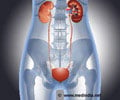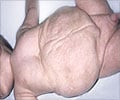Results from the NEPTUNE and NEPTUNE II studies indicate that several male patients with moderate-to-severe lower urinary tract symptoms may benefit from a single pill that contains two medications – tamsulosin and solifenacin.
An elderly male suffering from lower urinary symptoms like increased frequency of urination, waking up at night to pass urine, incomplete urination or dribbling of urine is most common symptom of an enlarged prostate that causes obstruction to flow of the urine and can be treated by either medication or surgery. Patients with borderline or moderate symptoms are mostly treated by a single medication such as Tamsulosin that relieves the obstruction. However, not all patients who receive the treatment with Tamsulosin recover completely. These patients often have another problem – an overactive urinary bladder that contracts more frequently than normal, thus making it necessary to urinate more frequently. Therefore, it is often necessary to treat both the conditions to relieve the patient completely from his symptoms.A combination of α-1 blocker with an antimuscarinic drug has been suggested in certain population of male patients with moderate-to-severe lower urinary tract symptoms who do not get relief with a single drug alone, and without a physical bladder outlet obstruction.
Alpha-1 blockers and Antimuscarinic Drugs in Treatment of Lower Urinary Tract Symptoms
The α-1 blockers, terazosin, doxazocin, tamsulosin and alfuzosin are drugs that are used in the treatment of lower urinary tract symptoms of prostate enlargement. They improve urinary flow and probably bring about their effect by relaxing the muscles of the prostate and improving circulation in the bladder neck and prostate.The antimuscarinic drug, solifenacin, reduces bladder contractions and increases bladder storage capacity. It is effective in patients with overactive bladder symptoms.
Thus, a combination of these two drugs is likely to be effective in patients with features of both prostate enlargement and overactive bladder.
Results from NEPTUNE Study
The NEPTUNE study evaluated the use of a single tablet containing tamsulosin and solifenacin in patients with moderate-to-severe lower urinary tract symptoms. The NEPTUNE study was conducted for 12 weeks and was followed by the NEPTUNE II extension, where patients had the option to continue treatment for another 40 weeks. Patients received a daily pill that contained 0.4 mg tamsulosin in a formulation referred to as ‘oral controlled absorption system formulation of tamsulosin (TOCAS)’, and either 6 mg or 9 mg of solifenacin. Initial treatment was with pills containing 6mg of solifenacin, but later on in the study, patients were given the option of switching between the 6mg and 9mg dosages.Common side effects associated with the use of the combination were dry mouth, constipation and dyspepsia. Since antimuscarinic drugs reduce the bladder contractions, there was a fear that solifenacin may cause retention of urine in the bladder as a side effect. In the NEPTUNE studies however, urinary retention was not a common side effect and was reported only in 1.1% patients. It must be noted that patients with features of bladder outlet obstruction (post-void residual urine ≥ 150 ml) were excluded from the study.














